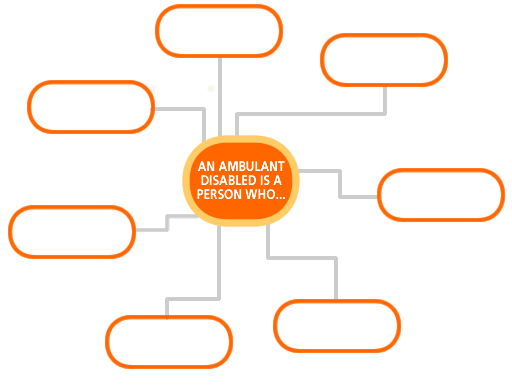

| STUDENT'S WORKSHEET | The Locomotor Disabled | The Ambulant Disabled | ||||||||||||||||||||||||||||||||||||||||||||||||||||||||||||||||||||||||||||||||
| 4.3.1. The Ambulant Disabled | ||||||||||||||||||||||||||||||||||||||||||||||||||||||||||||||||||||||||||||||||
| Activity 1 | ||||||||||||||||||||||||||||||||||||||||||||||||||||||||||||||||||||||||||||||||
|
:: Make groups of about 4 to 6. :: Concentrate and think of the main characteristics of a person who moves about using crutches or a stick. :: Brainstorm for ideas and write the results in the following cluster map. |
||||||||||||||||||||||||||||||||||||||||||||||||||||||||||||||||||||||||||||||||
|
|
||||||||||||||||||||||||||||||||||||||||||||||||||||||||||||||||||||||||||||||||
| Activity 2 | ||||||||||||||||||||||||||||||||||||||||||||||||||||||||||||||||||||||||||||||||
|
:: Present your results to the other groups in the class.
|
||||||||||||||||||||||||||||||||||||||||||||||||||||||||||||||||||||||||||||||||
| Activity 3 | ||||||||||||||||||||||||||||||||||||||||||||||||||||||||||||||||||||||||||||||||
|
:: Read 4.1 The Ambulant Disabled | A) Some Basic Characteristics and then add or make the necessary changes to your cluster map.
|
||||||||||||||||||||||||||||||||||||||||||||||||||||||||||||||||||||||||||||||||
| Activity 4 | ||||||||||||||||||||||||||||||||||||||||||||||||||||||||||||||||||||||||||||||||
|
:: Read 4.2 | B) Accessible Environments for the The Ambulant Disabled. :: The next chart shows a list of elements that should be adopted, adapted or avoided so that they do not represent a barrier for the ambulant disabled. ::
Tick ( :: Write a cross (x) if the element is not at all suitable for the ambulant disabled. ::
Tick (
|
||||||||||||||||||||||||||||||||||||||||||||||||||||||||||||||||||||||||||||||||
|
||||||||||||||||||||||||||||||||||||||||||||||||||||||||||||||||||||||||||||||||
| Activity 5 | ||||||||||||||||||||||||||||||||||||||||||||||||||||||||||||||||||||||||||||||||
|
:: Read, compare and comment on your results with the other groups. |
||||||||||||||||||||||||||||||||||||||||||||||||||||||||||||||||||||||||||||||||
| Written Exercises | ||||||||||||||||||||||||||||||||||||||||||||||||||||||||||||||||||||||||||||||||
| | 1 | 2 | 3 | 4 | | ||||||||||||||||||||||||||||||||||||||||||||||||||||||||||||||||||||||||||||||||
